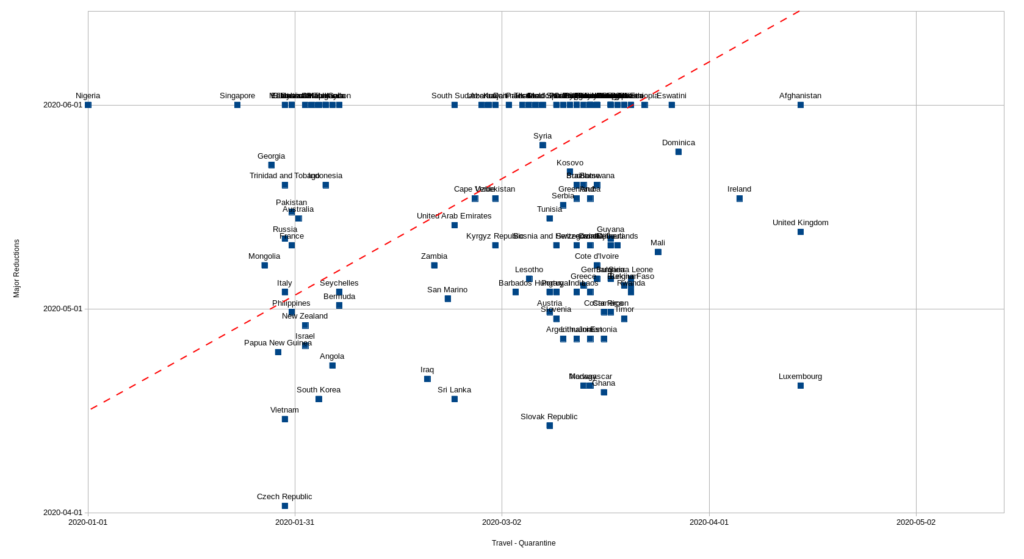Evidence from previous pandemics, and early simulations generated after the beginning of the 2020 coronavirus pandemic, suggested that travel bans are a common political tool for alleviating public anxieties, but have only limited effect in delaying international spread of the Covid-19 virus. However, other models projected that travel bans could be highly effective. As countries are gradually lifting lockdown measures around the world, data is becoming available to test how travel bans actually fared against the spread of the virus in this instance.
Alternative Hypothesis: Early travel restrictions against China resulted in early lifting of lockdown measures (presumably by assisting in preparation, containment, and reduction of spread).
Null Hypothesis: The timing of travel restrictions had no significant effect on the the timing of lockdown measures being relaxed (presumably not significantly contributing to the effectiveness of other lockdown measures).
I like the way this hypothesis focuses on exiting lockdown, rather than case counts or mortality rates, as the accuracy of these metrics is in question. On the other hand, exiting lockdown is as much a function of healthcare capacity, economic necessity, and political motives as it is a sign of containment.
Method:
I started with the Oxford Coronavirus Government Response Tracker (OxCGRT), a dataset graciously made publicly available by the Blavatnik School of Government at the University of Oxford – downloaded today (2020-05-28). Among other variables useful for testing the hypothesis in question, the OxCGRT provides a “StringencyIndex” value that represents a sum of all lockdown measures they track.
A short Python script converts this data to a table listing the following data:
- Country
- Travel – Quarantine: Date of first quarantine measures
- Travel – Ban: Date of first travel ban
- Max Restrictions: The maximum lockdown stringency level
- Reduce Restrictions: The date of first stringency reduction after the maximum lockdown level is last reached
- Major Reductions: The date at which stringency first decreased to less than 90% of maximum
Since some countries (eg, United Kingdom, Luxembourg, Afghanistan) did not ever institute travel restrictions, and many others (eg, United States, Denmark, Malaysia) have yet to significantly relax lockdown measures, I impugned these countries with outlier dates. Additionally, this hypothesis is only applicable to countries with lockdown measures sufficient to relax, so I excluded countries with maximum lockdown measures below 70 (eg, Sweden, Iceland, Taiwan). I also excluded China, for obvious reasons.
Results:
The resulting dataset of 145 countries is graphically displayed below (click image to enlarge).

The most interesting feature of this scatter-plot to me is the visually prominent appearance of 2 “blobs” of countries, one lined vertically around the quarantine date of 2020-02-01, and another larger one spread out a little more around 2020-03-15. Though a few countries (eg, Zambia, Sri Lanka, South Sudan) instituted travel bans somewhere between these dates, the vast majority of countries seem to congregate within these 2 waves of travel bans.
The alternative hypothesis, as stated above, would predict that countries in the first wave of travel restrictions would exit lockdowns sooner, while countries in the second wave would possibly still be in maximum lockdown now. This hypothesis is approximated by the red line added to the image (this is just a visual aid, not a correlation). Visual inspection does not support this hypothesis (r=0.09; p>0.1).
In addition to the limitations listed by the OxCGRT about the quality of their data, this analysis has many further limitations. I did try using travel bans instead of quarantines as the independent variable, and reduced restrictions rather than major reductions as the dependent variable, but this made little difference to the results. Similarly, removing potentially unreliable data sources such as all of Africa made no appreciable difference either. It may however, be useful to adjust lockdown reduction dates by the date of first identified case, as this date varies significantly per country, and may affect lockdown exit timing independently.
Discussion:
Relevant data for many countries has yet to be added and incorporated into the OxCGRT dataset. However, a trend already appears prominent in the available data to suggest that travel restrictions were not a major predictor of early reduction in lockdown measures across the world. This may be because asymptomatic carriers and poor testing meant that many carriers of the disease were already spreading the virus locally long before travel restrictions were instituted. Additional analysis is needed to determine if some combination of measures that includes travel restrictions was effective against spread and containment of the virus.
It is likely that many (possibly most) measures taken to combat the spread of Covid-19 were largely ineffective. This is a reasonable outcome based on limited information available at the time of onset of the pandemic, and hopefully some subset of measures that we will only know in hindsight has turned out to be effective. However, travel restrictions were already known in advance of the pandemic to have limited effect on spread, and yet most countries continue to enforce them even now, while lifting other lockdown measures. It is worth considering that the economic costs may outweigh any health benefits of continuing these bans.